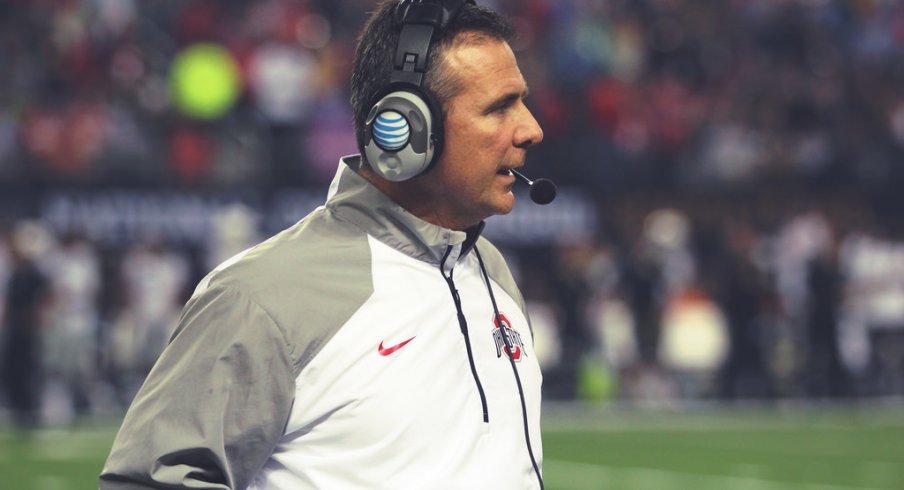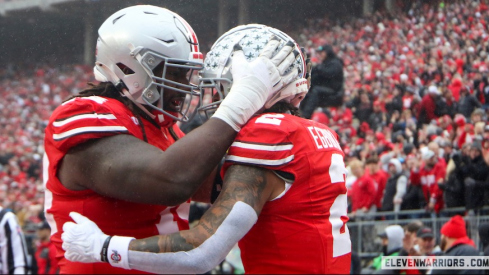One perception of Urban Meyer’s offenses at Ohio State, right or wrong, is that they have failed to utilize the tight end effectively in the passing game.
That refrain was often repeated Monday when Jeremy Ruckert, the No. 1 tight end recruit in the class of 2018, announced his commitment to Ohio State.
Will Ohio State’s offense enable Ruckert to maximize his pass-catching playmaking ability?
It’s a fair question, but also one that gives us an opportunity to look at the facts: How has Ohio State’s tight end production in the Meyer era compared to the competition?
For the purposes of this study, we’ll include the three other schools that made Ruckert’s final four: Michigan, Notre Dame and Wisconsin. We’ll also include every other team that has made at least one of the first three College Football Playoffs: Alabama, Clemson, Florida State, Michigan State, Oklahoma, Oregon and Washington. Finally, we’ll include every school that has had a first-round draft pick at tight end in the past five years, which adds Miami, Mississippi and North Carolina to the list.
The following table breaks down each team’s total receiving production from the tight end position over the past five years, sorted by receptions. Totals were determined based off of players listed as tight ends by CFBStats.com.
| SCHOOL | RECEPtiONS | YARDS | Touchdowns |
|---|---|---|---|
| WASHINGTON | 255 | 3301 | 32 |
| MICHIGAN | 253 | 3171 | 26 |
| MIAMI | 249 | 3664 | 28 |
| WISCONSIN | 243 | 3012 | 29 |
| MISSISSIPPI | 204 | 2862 | 19 |
| CLEMSON | 202 | 2579 | 32 |
| OREGON | 195 | 2764 | 30 |
| MICHIGAN STATE | 195 | 2354 | 27 |
| NORTH CAROLINA | 194 | 2770 | 20 |
| ALABAMA | 185 | 2316 | 16 |
| NOTRE DAME | 163 | 2184 | 20 |
| FLORIDA STATE | 161 | 2172 | 21 |
| OHIO STATE | 153 | 1951 | 20 |
| OKLAHOMA | 73 | 1116 | 19 |
Those numbers back up the assertions that Ohio State’s offense isn’t tight end-friendly. Oklahoma has used the tight end position minimally in recent years – the numbers in the table above include Mark Andrews’ 2016 stats even though he was listed as a wide receiver last year – and Ohio State’s tight ends combined for less receptions and less receiving yards than every other team surveyed.
There are other factors that should be considered, though, before jumping to the conclusion that Ohio State’s offense is a black hole for tight ends.
The following table looks at market share percentages for each team’s tight end receiving production, comparing the tight ends’ combined numbers over the past five years to the team’s overall receiving stats, this time sorted by market share of receptions:
| SCHOOL | % OF RECEPTIONS BY TE | % OF YARDS BY TE | % OF TOUCHDOWNS BY TE |
|---|---|---|---|
| WISCONSIN | 23.9 | 24.5 | 36.3 |
| MICHIGAN | 23.4 | 23.1 | 28.3 |
| MIAMI | 20.0 | 21.0 | 23.5 |
| WASHINGTON | 19.8 | 21.0 | 25.2 |
| MICHIGAN STATE | 16.5 | 16.0 | 25.0 |
| OREGON | 14.7 | 15.4 | 17.4 |
| MISSISSIPPI | 14.2 | 15.5 | 14.2 |
| ALABAMA | 14.0 | 13.8 | 11.3 |
| OHIO STATE | 13.7 | 14.0 | 14.1 |
| NOTRE DAME | 13.7 | 13.4 | 16.3 |
| NORTH CAROLINA | 13.3 | 15.2 | 13.6 |
| CLEMSON | 11.7 | 12.1 | 17.6 |
| FLORIDA STATE | 11.4 | 11.4 | 15.3 |
| OKLAHOMA | 5.3 | 6.3 | 12.5 |
While Ohio State’s tight end market shares are in the bottom half of all three major statistical categories among the 14 teams surveyed, the Buckeyes’ usage of their tight ends within their passing offense is closer to the median than the raw numbers suggest.
Meyer’s Buckeyes haven’t passed the ball as much as some of the nation’s other top teams, which has impacted the numbers of all Ohio State receivers – not just tight ends – over the past five years. If the Buckeyes continuing to run the ball more frequently than their competition, that’s not a bad thing for Ruckert and OSU’s other tight ends of the future. While run blocking isn’t as sexy as pass catching, every running play is a potential opportunity for a tight end to make an impact – which also means another opportunity to impress NFL scouts.
As it relates specifically to Ruckert, or to other potential top tight end recruits, the real question is whether an individual tight end can put up big numbers in the offense. So it’s worth taking a look at the best individual seasons from the last five years by a tight end at each of the 14 surveyed schools, this time ranked by receiving yards:
| SCHOOL | PLAYER (YEAR) | RECEPTIONS | YARDS | TOUCHDOWNS |
|---|---|---|---|---|
| NORTH CAROLINA | ERIC EBRON (2013) | 62 | 973 | 3 |
| MISSISSIPPI | EVAN ENGRAM (2016) | 65 | 926 | 8 |
| WASHINGTON | AUSTIN SEFERIAN-JENKINS (2012) | 69 | 852 | 7 |
| MICHIGAN | DEVIN FUNCHESS (2013) | 49 | 748 | 6 |
| CLEMSON | JORDAN LEGGETT (2016) | 46 | 736 | 7 |
| MIAMI | DAVID NJOKU (2016) | 43 | 698 | 8 |
| NOTRE DAME | TYLER EIFERT (2012) | 50 | 685 | 4 |
| FLORIDA STATE | NICK O'LEARY (2014) | 48 | 618 | 6 |
| ALABAMA | O.J. HOWARD (2015) | 38 | 602 | 2 |
| WISCONSIN | TROY FUMAGALLI (2016) | 47 | 580 | 2 |
| OKLAHOMA | MARK ANDREWS (2016) | 31 | 489 | 7 |
| MICHIGAN STATE | DION SIMS (2012) | 36 | 475 | 2 |
| OHIO STATE | JEFF HEUERMAN (2013) | 26 | 466 | 4 |
| OREGON | PHARAOH BROWN (2016) | 33 | 426 | 5 |
Ohio State ranks at or near the bottom in all three categories again, giving credence to the argument that Meyer’s offense does not produce star tight ends.
The other side of that equation, though, is that Ohio State hasn’t necessarily had a tight end who was capable of putting up huge numbers.
Additionally, a closer look at some of the other schools shows that their tight end production has gone up substantially when they have had stars at the position. North Carolina, for example, has actually had less receiving production than Ohio State at the tight end position over the last three years. That didn’t stop future NFL first-round draft pick Eric Ebron, with the same offensive-minded head coach in Larry Fedora, from being one of college football’s most productive tight ends in 2012 and 2013.
The case can be made that if Ruckert was to pick the school that would get the most out of him as a tight end, he should have picked Wisconsin or Michigan, which have stronger recent histories of production at the position. Yet there’s reason to believe a player as talented as Ruckert can achieve a high level of production and emerge as one of college football’s best tight ends even while playing within Meyer’s offense.
While Ohio State’s tight ends haven’t put up big numbers in the Meyer era, they’ve still caught the eyes of NFL scouts; Heuerman was a third-round draft pick in 2015 and Nick Vannett was a third-round pick in 2016.
Ruckert has the potential to be a significantly better prospect than either of them were, which could open the door to a more regular pass-catching role in the Ohio State offense. He and the tight ends already on the roster will also have the advantage of working with a new offensive coordinator, Kevin Wilson, who has a history of developing statistically productive tight ends, as noted by Eleven Warriors’ Andrew Lind:
Wilson helped turn Jermaine Gresham into a first-round pick at Oklahoma. Recorded 66 catches for 950 yards and 14 touchdowns in 2008.
— Andrew Lind (@AndrewMLind) July 17, 2017
Compared to some of the nation’s other top teams, Ohio State’s tight end production over the last five years has been consistently below average. That point could continue to be exploited by recruiting opponents and their fan bases. There’s reason for optimism, though, that the best is yet to come for Ohio State tight ends in Meyer’s coaching tenure.


